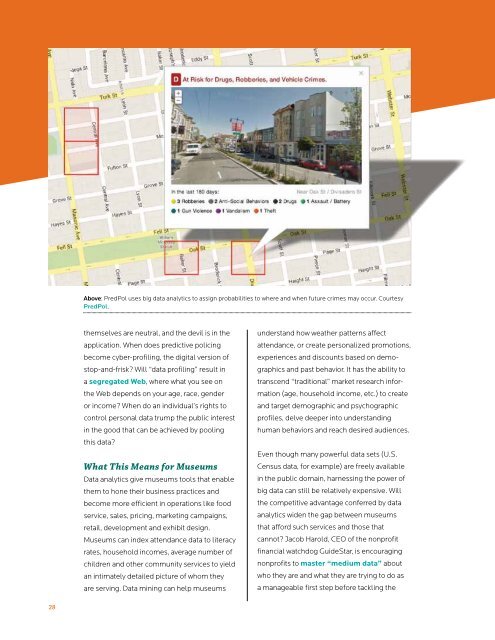1kLPuWX
1kLPuWX
1kLPuWX
Create successful ePaper yourself
Turn your PDF publications into a flip-book with our unique Google optimized e-Paper software.
Above: PredPol uses big data analytics to assign probabilities to where and when future crimes may occur. Courtesy<br />
PredPol.<br />
themselves are neutral, and the devil is in the<br />
application. When does predictive policing<br />
become cyber-profiling, the digital version of<br />
stop-and-frisk? Will “data profiling” result in<br />
a segregated Web, where what you see on<br />
the Web depends on your age, race, gender<br />
or income? When do an individual’s rights to<br />
control personal data trump the public interest<br />
in the good that can be achieved by pooling<br />
this data?<br />
What This Means for Museums<br />
Data analytics give museums tools that enable<br />
them to hone their business practices and<br />
become more efficient in operations like food<br />
service, sales, pricing, marketing campaigns,<br />
retail, development and exhibit design.<br />
Museums can index attendance data to literacy<br />
rates, household incomes, average number of<br />
children and other community services to yield<br />
an intimately detailed picture of whom they<br />
are serving. Data mining can help museums<br />
understand how weather patterns affect<br />
attendance, or create personalized promotions,<br />
experiences and discounts based on demographics<br />
and past behavior. It has the ability to<br />
transcend “traditional” market research information<br />
(age, household income, etc.) to create<br />
and target demographic and psychographic<br />
profiles, delve deeper into understanding<br />
human behaviors and reach desired audiences.<br />
Even though many powerful data sets (U.S.<br />
Census data, for example) are freely available<br />
in the public domain, harnessing the power of<br />
big data can still be relatively expensive. Will<br />
the competitive advantage conferred by data<br />
analytics widen the gap between museums<br />
that afford such services and those that<br />
cannot? Jacob Harold, CEO of the nonprofit<br />
financial watchdog GuideStar, is encouraging<br />
nonprofits to master “medium data” about<br />
who they are and what they are trying to do as<br />
a manageable first step before tackling the<br />
28


